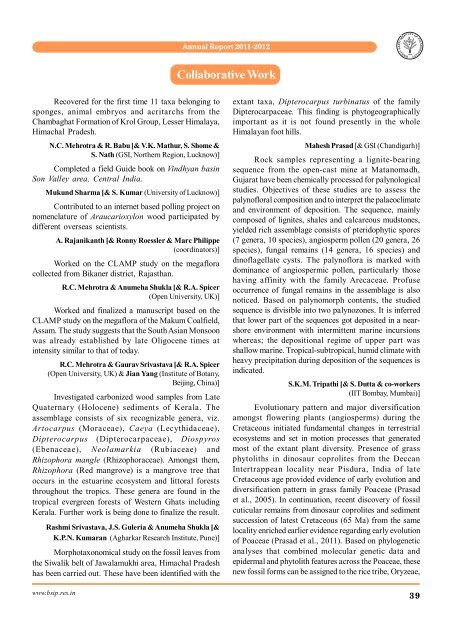Annual Report 2011-2012 - Birbal Sahni Institute of Palaeobotany
Annual Report 2011-2012 - Birbal Sahni Institute of Palaeobotany
Annual Report 2011-2012 - Birbal Sahni Institute of Palaeobotany
Create successful ePaper yourself
Turn your PDF publications into a flip-book with our unique Google optimized e-Paper software.
EBIRBAL SAHNI INSTITUT<br />
<strong>Annual</strong> <strong>Report</strong> <strong>2011</strong>-<strong>2012</strong><br />
Collaborative Work<br />
1946<br />
OF PALAEOBOTANY<br />
Recovered for the first time 11 taxa belonging to<br />
sponges, animal embryos and acritarchs from the<br />
Chambaghat Formation <strong>of</strong> Krol Group, Lesser Himalaya,<br />
Himachal Pradesh.<br />
N.C. Mehrotra & R. Babu [& V.K. Mathur, S. Shome &<br />
S. Nath (GSI, Northern Region, Lucknow)]<br />
Completed a field Guide book on Vindhyan basin<br />
Son Valley area, Central India.<br />
Mukund Sharma [& S. Kumar (University <strong>of</strong> Lucknow)]<br />
Contributed to an internet based polling project on<br />
nomenclature <strong>of</strong> Araucarioxylon wood participated by<br />
different overseas scientists.<br />
www.bsip.res.in<br />
A. Rajanikanth [& Ronny Roessler & Marc Philippe<br />
(coordinators)]<br />
Worked on the CLAMP study on the megaflora<br />
collected from Bikaner district, Rajasthan.<br />
R.C. Mehrotra & Anumeha Shukla [& R.A. Spicer<br />
(Open University, UK)]<br />
Worked and finalized a manuscript based on the<br />
CLAMP study on the megaflora <strong>of</strong> the Makum Coalfield,<br />
Assam. The study suggests that the South Asian Monsoon<br />
was already established by late Oligocene times at<br />
intensity similar to that <strong>of</strong> today.<br />
R.C. Mehrotra & Gaurav Srivastava [& R.A. Spicer<br />
(Open University, UK) & Jian Yang (<strong>Institute</strong> <strong>of</strong> Botany,<br />
Beijing, China)]<br />
Investigated carbonized wood samples from Late<br />
Quaternary (Holocene) sediments <strong>of</strong> Kerala. The<br />
assemblage consists <strong>of</strong> six recognizable genera, viz.<br />
Artocarpus (Moraceae), Caeya (Lecythidaceae),<br />
Dipterocarpus (Dipterocarpaceae), Diospyros<br />
(Ebenaceae), Neolamarkia (Rubiaceae) and<br />
Rhizophora mangle (Rhizophoraceae). Amongst them,<br />
Rhizophora (Red mangrove) is a mangrove tree that<br />
occurs in the estuarine ecosystem and littoral forests<br />
throughout the tropics. These genera are found in the<br />
tropical evergreen forests <strong>of</strong> Western Ghats including<br />
Kerala. Further work is being done to finalize the result.<br />
Rashmi Srivastava, J.S. Guleria & Anumeha Shukla [&<br />
K.P.N. Kumaran (Agharkar Research <strong>Institute</strong>, Pune)]<br />
Morphotaxonomical study on the fossil leaves from<br />
the Siwalik belt <strong>of</strong> Jawalamukhi area, Himachal Pradesh<br />
has been carried out. These have been identified with the<br />
extant taxa, Dipterocarpus turbinatus <strong>of</strong> the family<br />
Dipterocarpaceae. This finding is phytogeographically<br />
important as it is not found presently in the whole<br />
Himalayan foot hills.<br />
Mahesh Prasad [& GSI (Chandigarh)]<br />
Rock samples representing a lignite-bearing<br />
sequence from the open-cast mine at Matanomadh,<br />
Gujarat have been chemically processed for palynological<br />
studies. Objectives <strong>of</strong> these studies are to assess the<br />
palyn<strong>of</strong>loral composition and to interpret the palaeoclimate<br />
and environment <strong>of</strong> deposition. The sequence, mainly<br />
composed <strong>of</strong> lignites, shales and calcareous mudstones,<br />
yielded rich assemblage consists <strong>of</strong> pteridophytic spores<br />
(7 genera, 10 species), angiosperm pollen (20 genera, 26<br />
species), fungal remains (14 genera, 16 species) and<br />
din<strong>of</strong>lagellate cysts. The palyn<strong>of</strong>lora is marked with<br />
dominance <strong>of</strong> angiospermic pollen, particularly those<br />
having affinity with the family Arecaceae. Pr<strong>of</strong>use<br />
occurrence <strong>of</strong> fungal remains in the assemblage is also<br />
noticed. Based on palynomorph contents, the studied<br />
sequence is divisible into two palynozones. It is inferred<br />
that lower part <strong>of</strong> the sequences got deposited in a nearshore<br />
environment with intermittent marine incursions<br />
whereas; the depositional regime <strong>of</strong> upper part was<br />
shallow marine. Tropical-subtropical, humid climate with<br />
heavy precipitation during deposition <strong>of</strong> the sequences is<br />
indicated.<br />
S.K.M. Tripathi [& S. Dutta & co-workers<br />
(IIT Bombay, Mumbai)]<br />
Evolutionary pattern and major diversification<br />
amongst flowering plants (angiosperms) during the<br />
Cretaceous initiated fundamental changes in terrestrial<br />
ecosystems and set in motion processes that generated<br />
most <strong>of</strong> the extant plant diversity. Presence <strong>of</strong> grass<br />
phytoliths in dinosaur coprolites from the Deccan<br />
Intertrappean locality near Pisdura, India <strong>of</strong> late<br />
Cretaceous age provided evidence <strong>of</strong> early evolution and<br />
diversification pattern in grass family Poaceae (Prasad<br />
et al., 2005). In continuation, recent discovery <strong>of</strong> fossil<br />
cuticular remains from dinosaur coprolites and sediment<br />
succession <strong>of</strong> latest Cretaceous (65 Ma) from the same<br />
locality enriched earlier evidence regarding early evolution<br />
<strong>of</strong> Poaceae (Prasad et al., <strong>2011</strong>). Based on phylogenetic<br />
analyses that combined molecular genetic data and<br />
epidermal and phytolith features across the Poaceae, these<br />
new fossil forms can be assigned to the rice tribe, Oryzeae,<br />
39

















